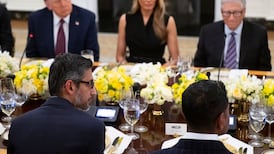Thirty years ago today, on December 15th, 1993, I travelled to Downing Street to witness one of the key moments in 20th century Irish history – the signing of a Joint Declaration by Albert Reynolds and John Major on the future of the island. It was the basis for the IRA ceasefire eight months later.
In the years since, the declaration has often been taken for granted, but it was arguably more significant than the Belfast Agreement which followed five years later, as it delivered the formula for peace on which subsequent events hinged. The crucial feature of the declaration was the acceptance by the British government that it was for the people of the island of Ireland alone, by agreement between the two parts, to exercise their right of self-determination on the basis of consent. The reference to self-determination was critical to weaning the IRA off violence, while the acceptance by nationalist Ireland of the principle of consent in advance of unity was crucial to winning unionist acceptance.
The Belfast Agreement would never have been possible without the Downing Street Declaration, which set out the basic principles on which future constitutional changes would rest. They were the acceptance by the British of the principle of self-determination for the people of the island and the acceptance by nationalist Ireland of the principle of consent as a prerequisite for unity.
The Declaration was the culmination of months of intense negotiations between Reynolds and Major and their teams of officials. Right up to the end there were serious doubts about whether the process, which involved 20 drafts of the document, would deliver a significant breakthrough or end in failure and bitter recrimination.
READ MORE
Albert Reynolds was lucky that in John Major he found a British prime minister who was equally committed to finding a solution. They established a personal rapport unique in British-Irish relations
Less than two weeks earlier, at a special summit in Dublin Castle, it all appeared to be going off the rails when the two prime ministers got locked into a heated argument. It occurred after the British proposed yet another draft of the declaration to replace the working text which had been laboriously put together by officials from both sides.
“You are trying to make a fool out of me, John, and I won’t have it. We’ll not do business on the basis of this,” barked Reynolds, throwing the new draft at Major. Except Reynolds didn’t use the word “fool” but something much more crude and unprintable.
Major, who was holding a pencil at the time, was so shocked that he snapped it in half. He suggested that they should retire from the negotiating table for a one-to-one meeting. All of the officials present held their breath, wondering if months of tireless effort was about to go down the drain.
When the two men emerged after half an hour, they both looked a bit pale but they were still on speaking terms. “How did it go, Taoiseach?” asked Fergus Finlay, who was on the Irish team as special adviser to Labour leader and minister for foreign affairs Dick Spring. “It wasn’t too bad. He chewed the b****x off me but I took a few lumps out of him,” remarked Reynolds.
[ The Path to Peace: A timeline of the peace process in the 1990sOpens in new window ]
Major, too, was reasonably optimistic despite the confrontation. As he headed into the anteroom with Reynolds he sent a note to his private secretary saying: “Don’t worry. I’m not really angry.” In fact he snapped the pencil in shock at the Taoiseach’s “unparliamentary language” rather than anger at the substance of the objection.
Less than two weeks after this confrontation, Reynolds travelled to Downing Street to sign the Joint Declaration. As he went into the famous building, he was acutely conscious that he was walking in the footsteps of Michael Collins and Arthur Griffith, who had signed the Anglo-Irish Treaty there in 1922.
Reynolds, who on taking office had been dismissed as a “country and western taoiseach” by snobbish commentators, surprised everybody on his first day in office in early 1992 by saying that bringing an end to violence in the North was his primary objective.
For the next year Reynolds kept repeating the mantra: “Who’s afraid of peace?” He managed to convince the Irish political system and the British that the key to a solution was first to find a formula for peace and work out a detailed political solution later. It was an approach that turned conventional political wisdom on its head, and many doubted that it would work.
[ Reynolds told Major of commitment to end NI conflictOpens in new window ]
Reynolds was lucky that in John Major he found a British prime minister who was equally committed to finding a solution. They established a personal rapport unique in British-Irish relations that brought the process to a successful conclusion despite furious arguments along the way.
The detailed work was done by dedicated officials on both sides. The legendary Irish cabinet secretary Dermot Nally led the team that persuaded the British of the necessity for an agreement. Meanwhile, the Taoiseach’s adviser Martin Mansergh engaged with Belfast based priest Fr Alec Reid to establish a line of communications with the IRA leadership and persuade them the deal would provide the basis for a ceasefire.
Ultimately, though, the declaration and all the subsequent developments from the ceasefires to the Belfast Agreement only happened because Albert Reynolds was prepared to risk everything in the search for peace. It is his outstanding political legacy.
Some of the key documents from the negotiations, including Dermot Nally’s annotated drafts of the text, are available online from the Quill Project at Pembroke College Oxford in co-operation with UCD.













